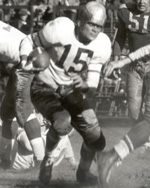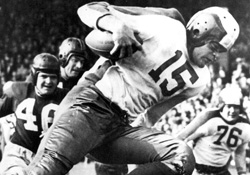Steve Van Buren, 1920-2012
Hall of Famers
Published on : 8/24/2012
 Pro Football Hall of Fame running back Steve Van Buren died on Thursday. He was 91. The legendary Philadelphia Eagles runner was one of the National Football League’s greatest stars during his career that spanned eight seasons from 1944 to 1951.
Pro Football Hall of Fame running back Steve Van Buren died on Thursday. He was 91. The legendary Philadelphia Eagles runner was one of the National Football League’s greatest stars during his career that spanned eight seasons from 1944 to 1951.“I am saddened to learn of Steve Van Buren’s passing,” commented the Pro Football Hall of Fame’s President/Executive Director Steve Perry. “His legacy was built during an era that helped lift the game’s image across this country. His athletic exploits made him one of the sport’s treasured stars and his contributions will be forever preserved in the Pro Football Hall of Fame.”
Drafted out of Louisiana State by the Eagles as the fifth overall pick of the 1944 NFL Draft, Van Buren instantly became a star. Only injuries that forced him to miss games kept him from winning the rushing title as a rookie. A year later, he earned the first of four career rushing crowns. He also accomplished a rare “triple crown” that season when he led the NFL in three major statistical categories – rushing, scoring, and kickoff returns.
In 1947, he added the first of three straight rushing crowns when he eclipsed the 1,000-yard mark for the first time of his career. He was just the second player ever in NFL history to reach the milestone number. His best season total came during the Eagles’ championship season in 1949 when he gained a career-high and then-record 1,146 yards. That mark stood for nearly a decade, despite an increased emphasis on offense each year in the NFL during that era.
The story of Steve’s early years is not a particularly happy one. Born in 1920 in LaCeiba, Honduras, where his father was a fruit inspector, Van Buren was orphaned at a very young age and sent to New Orleans to live with his grandparents.
When he first thought of football as a sophomore at Warren Easton High School, his coach advised him to forget about it because Van Buren weighed only 125 pounds. For the next two years, Steve worked in an iron foundry. When he returned to high school, he played football well enough to earn a scholarship to LSU.
For two years under Coach Bernie Moore, he toiled as a blocking back, and then got his chance as a running back during his junior season. In a splendid senior season, he accumulated 832 yards rushing. But, he did not win All-American acclaim and thus not too many pro teams had the Tigers’ star on their radar. But, Philadelphia, tipped off by Coach Moore, gambled on the runner and the move paid off immediately.
Van Buren, despite missing games due to an appendectomy, earned All-NFL honors as a rookie. It was the first of six straight years he earned such acclaim. Without a doubt, Van Buren was one of the league’s finest players for an Eagles team that remained near the top of the league for most of Van Buren’s years in the NFL.
Perhaps the truest yardstick of Van Buren’s contribution to pro football can be found by studying the record of the Eagles. The team’s fortunes seemed to teeter on whether or not Van Buren was in the lineup. The team’s success waned after Van Buren was slowed by severe injuries that reduced his effectiveness at the end of his career.
 Philadelphia had never climbed above fourth place in the five-team Eastern Division nor posted a winning record since they joined the league in 1933 until Van Buren’s arrival in 1944. With “Bayou Boy” leading the way, the Eagles led the NFL in scoring and finished 7-1-2 to grab second place in the competitive division. Philly narrowly missed winning the division again in 1945 and 1946. Then, Van Buren and the Eagles strung together three straight division titles from 1947-49 and claimed back-to-back world championships in 1948 and ’49.
Philadelphia had never climbed above fourth place in the five-team Eastern Division nor posted a winning record since they joined the league in 1933 until Van Buren’s arrival in 1944. With “Bayou Boy” leading the way, the Eagles led the NFL in scoring and finished 7-1-2 to grab second place in the competitive division. Philly narrowly missed winning the division again in 1945 and 1946. Then, Van Buren and the Eagles strung together three straight division titles from 1947-49 and claimed back-to-back world championships in 1948 and ’49.Atrocious playing conditions and a rock solid defense combined to give the Eagles shutout wins in their consecutive championship game victories. In 1949, playing on the muddy field at Los Angeles Coliseum, the Eagles upset the Los Angeles Rams, 14-0, and Steve carried the ball 31 times for a spectacular 196 yards which was the most ever in an NFL championship game.
But as great as that game was for Van Buren, arguably his best game of all time came a year earlier when the Eagles met the Cardinals in Philadelphia for the 1948 championship. Van Buren barely made it to the stadium as the “City of Brotherly Love,” experienced a blizzard that day. Even though more than 36,000 hardy fans managed to make their way to the game, Commissioner Bert Bell gave the players the choice of playing the game or postponing it.
The players voted to go ahead. For three quarters, the Cardinals – who had defeated Philadelphia in the championship game one year earlier – and the Eagles fought to a scoreless tie on a field where all markings were obliterated by deep snow and where ordinary type of play was impossible.
Near the end of the third quarter, Chicago fumbled on its own 17 yard-line, and Philadelphia had its now-or-never chance. Four plays later, just after the final quarter had started, Van Buren barreled over from the five-yard-line for what proved to be the game’s only score. The Eagles won 7-0 and earned the franchise’s first world title.
Van Buren’s personal accomplishments are many but his leadership and ability to help the Eagles reach championship status is his true indelible mark on the game. Injuries slowed him significantly during his last two seasons but he left the game as the NFL’s all-time leading rusher. In all, he averaged 4.4 yards per carry to rack up his record 5,860 yards and scored 69 rushing touchdowns. He also added 523 yards on 45 catches and 3 TDs; 2,030 yards and 3 touchdowns on kickoff returns; 473 punt return yards and 2 TDs; along with 9 career interceptions; and he kicked a pair of extra points.
He was named to the NFL’s All-Decade Team of the 1940s. Van Buren was also picked for the NFL’s 75th Anniversary Team in 1994 at running back as well as recognized on the two-way team as a running back and defensive back. He was the last living member of the Pro Football Hall of Fame’s Class of 1965 and one of 12 Pro Football Hall of Fame members to live to the age of 90 or older.
Previous Article
Van Buren retired as game's leading rusher
Steve Van Buren became the NFL's all-time leading ground gainer on Oct. 3, 1949.
Next Article
Dave Robinson's career in photos
View photos of Dave Robinson during his career.

